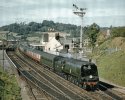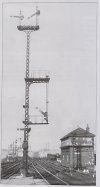Ferris boy
New Member
Whilst preparing a recent talk I found a 1953 photo of a a semaphore signal on the ECML at Alnmouth at least 80ft high, but cannot find any records of UK signal heights to see if it was the tallest. The only other one I've found was 86ft ? at Dalston Junction. Can anyone confirm where the tallest was and what height ?



